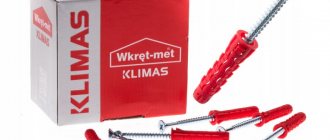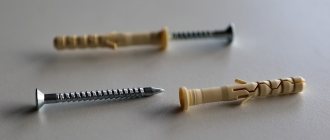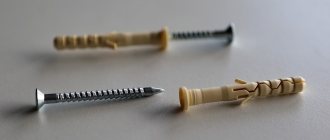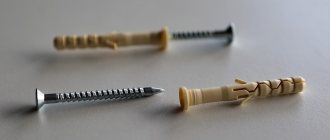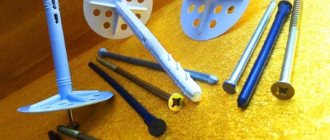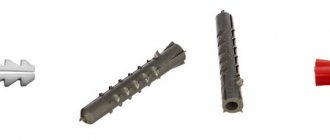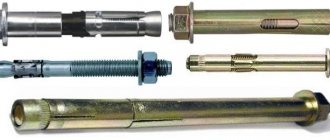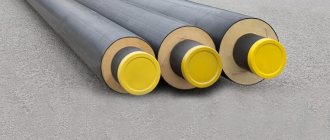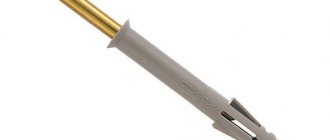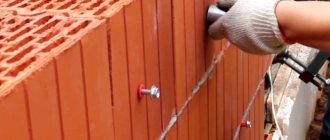Today there is no need to use nails to hang a picture, shelf, cabinet or other piece of furniture and decor. Firstly, it is inconvenient, and secondly, it is unreliable. Any fastener must be reliable; it is better to choose dowels that are installed in a pre-drilled hole. The reliability of such fastening directly depends on the correctly selected drill; the smaller the difference in the diameter of the hole and the rod, the stronger it will be installed. We’ll figure out how to choose a drill for a dowel further.
Basic selection principles
The correct choice of drill for the dowel should be based on the following:
- When calculating which hole to drill for the dowel, it is worth considering the type of wall into which the rod is installed and what it is covered with.
- Weight of attached furniture and maximum possible loads.
Considering the above parameters, you can choose the appropriate tool correctly. To make it easier, you need to take into account the factory size of the drill and fasteners, as well as the tensile strength of the dowel. There are markings on the tool, based on which it is easy to select the desired model.
If the wall material is very strong, for example concrete, you should choose two types of drills and different operating modes of the drill. To begin with, you should take a drill several sizes smaller than the dowels, switch the drill to impact mode and make the necessary hole. Then, using a gimlet of identical size with fasteners, in normal mode, bring the hole to the required parameters.
With the help of such manipulations, you can carry out work faster, do not overload the drill, get an ideally shaped hole and maintain the integrity of the wall and its coating. The rod in the hole should not rotate and move freely in it. Instead of a drill, it is better to choose a hammer drill, as it is more powerful and productive.
If the wall material is loose, it is better that the drill size is several sizes smaller than the rod (for example, for an 8 dowel, a drill size 6 or 7). This will allow the fasteners to be installed tightly, even in the event of excessive destruction of the wall structure.
When choosing the type of drill, you should pay attention to pobedit ones, given their high strength and durability.
The length of the hole should be several millimeters longer than the length of the dowel. This is necessary to ensure that it fits tightly into the niche over its entire length, since dust can accumulate in the hole.
Securing light objects
Fastening shelves, pictures and other light objects does not require special preparation or the presence of a powerful tool. All you need is a power tool, a simple dowel and a suitable drill bit for the dowel. This type of fastener is excellent for concrete and brick walls. It can also be mounted in the ceiling, for which you need to make a hole for dowel 6. Size 4 fasteners are suitable for walls. For walls of this type, a pobedit tip is best suited. In most cases, two mounting points will be sufficient.
Fastening medium-weight products
If the weight of the mounted decorative element exceeds 5 kg, more reliable fasteners are needed. A dowel with a diameter of 8 mm is suitable and, accordingly, the drill diameter is also 8 mm. A hole length of 6 cm is quite enough when working with ordinary walls; when working with loose material or a ceiling, the depth is increased to 8.
If the weight of an object approaches 10 kg, for reliability it is worth installing 4 fasteners, since 2 may not hold it. It is better to use a hammer drill as a tool.
All about dowel-nails: size table and fastener weight
Table of contents:
Let's imagine a typical task: you need to fix a heavy shelf for books on the concrete wall of a room. Self-tapping screws cannot be used. It will fall out. In Soviet times, a wooden dowel or, in other words, a chopik was inserted into a drilled hole for sealing. Nowadays a dowel-nail is used as a fastener: dimensions start from 5x30 mm. Here 5 is the diameter of the hole in the sleeve, and 30 is the length of the nail itself.
Securing heavy objects
Heavy furniture or household appliances that are mounted on the wall carry significant physical stress. Even if the fastener looks reliable at first, it can fail over time. Installation of heavy objects should only be carried out on walls made of durable materials, concrete or brick. Loose material can collapse under the influence of heavy weight. The normal diameter of the fastener is 10 mm, and the depth of the hole is more than 6 cm; you need to rely on these indicators to determine the diameter of the drill. For reliability, the recommended number of mounting points is at least 6. When choosing which drill to drill with, you can safely choose victorious ones.
To ensure that the attached structure can withstand about 100 kg, it is better to use anchor bolts.
They are more reliable, even given their smaller size. You should make a hole up to 6 cm deep and install the selected bolt.
There are 3 types:
- A bolt with an outer nut that is tightened with a regular wrench.
- Self-locking nut that can be tightened with a screwdriver.
- Double-expansion anchors, which are used for fastening the most massive furniture.
Peculiarities
A dowel is a sleeve made of any material with ribs located on the outside of the product to securely fix and prevent rotation during operation.
The main distinguishing feature of a nylon dowel is its longer service life. It can last more than 10 times longer than polyethylene. They have been in use in European countries for more than half a century. They are made from a special material - polyamide, which does not age over time and does not shrink. These properties of this type of plastic allow you to use nylon dowels for many years without fear for their reliability.
Another feature is the fairly wide temperature range at which such fasteners can be used - it ranges from -40 to +80 degrees Celsius. It should be noted that it can be used at lower temperatures at your own peril and risk: deformation and rupture may occur, or the dowel will not completely fit into place. But, as practice has shown, it will still hold better than regular polyethylene.
Due to the high degree of strength and reliability, this type of fastener can withstand loads approximately 3 times higher than fastening rods made of simple plastic. The only negative compared to the others is the higher cost due to the fact that a higher quality type of plastic is used.
Nylon fasteners have another interesting feature: if you put them in water, they will sink, unlike their other plastic counterparts.
Attaching to an unstable surface
Modern houses have many surfaces made of not very durable materials. These include drywall, old brick, wooden boards or slabs of pressed sawdust. When working with them, it is better to use nylon fasteners with a diameter of more than 10 mm; the installation depth should not be less than 6 cm. It is better to choose a gimlet that is several sizes smaller.
The drilling process should be shock-free, as excessive load can damage the surface. Using the impact mode may not leave visible damage, but the internal structure of the wall may be damaged. If the diameter of the drill is too large, the fasteners will move freely in the hole, gradually increasing its diameter, especially if the work was carried out with aerated concrete.
For plasterboard walls, it is not necessary to use a drill of a smaller diameter, the main thing is not to put pressure on the drill and not to use the impact mode. Drywall is a very delicate material, even a small load can lead to the destruction of a section of the wall. Drill the hole with light force so that it matches the size of the plastic dowel with self-tapping screw.
It is worth understanding that there is no need to attach heavy structures to such surfaces, even if the material initially copes with the load, over time, collapse may occur under heavy weight.
If you take into account the material from which the wall is made, choose the right dowel and drill for it, and also have a high-quality tool on hand, you can make a high-quality installation and not worry about the safety of your furniture or household appliances. By following the recommendations, even an inexperienced craftsman can handle such installation.
Which dowel is the most powerful?
Quick response
The strongest dowel is Hartmut from Knauf, withstood 78 kg. The weakest is Driva, which collapsed at 28 kg.
I picked up two videos with visual tests of dowels. This is the second part from the Stroyhak channel and a video from Victor Melnik. These two videos show all the drywall anchors available in stores. Below, after the video, I will summarize all the results in a table and give my explanations.
The second part from Stroyhak. The same canter and exact numbers. At the end of the video there is a bonus - a comparison of dowels with a mortgage.
Expert
Video author: Stroyhak
Stroyhak is a channel about construction and repair on YouTube with more than 1 million subscribers! The author of the channel, Andrey, shares useful tips, tricks, life hacks, tool reviews and other useful things for improving your apartments.
Construction hack on social networks:
And here is a test video from Viktor Melnik. Victor does not have a canter, but the tests are close to real ones. Look how powerful Hartmut's dowel turned out to be and how screwed Driva's dowel was.
Expert
Video author: Victor Melnik
I am engaged in the design and construction of frame houses, I maintain a blog on YouTube, where I share the secrets of construction and finishing.
Victor Melnik on social networks:
All tests were carried out on one layer of 12.5mm thick plasterboard.
Now the table. In the “Working Load” column, the maximum weight per fastener is indicated, the recommended destruction weight of drywall is indicated. This is an experimental weight to evaluate the fastener's potential. I recommend sticking to the values from the “Workload” column when calculating and not exceeding them.
Here's what happened (all numbers are for one layer of 12.5mm drywall):
| № | Dowel type | Work load | Destruction |
| 1 | Hartmut | 35kg | 78kg |
| 2 | Fischer | 25kg | 70kg |
| 3 | Butterfly | 30kg | 70kg |
| 4 | Folding | 50kg | 55kg |
| 5 | Legs | 30kg | 48kg |
| 6 | Molly (umbrella) | 25kg | 47kg |
| 7 | Driva (plastic) | 25kg | 28kg |
I would like to make some clarification on some types of dowels.
Butterfly. In order for the butterfly to withstand the load, it must be properly secured. There are nuances. I described everything in detail in the article on how to attach a butterfly dowel.
Fischer . The video from Stroyhak shows a Fischer dowel of an unknown model. I couldn't find it for sale or even in an image search. This dowel is similar to the Fischer UX, but the match is not 100%. Fischer UX is designed for hollow structures and curls in much the same way as a butterfly. In any case, Fischer is a high-quality fastener and Fischer UX will not be worse than the one in the video.
Umbrella . The author of the video calls a spring folding anchor an umbrella. This is not true. It is correct to call Molly's dowel an umbrella. You can verify this on the Knauf website.
Driva . The destruction weight of the gypsum plasterboard in the tests at the Stroyhak channel and at Viktor Melnik is very different. For Victor, this figure is half as much and is 28 kg. I recommend going for a lower value. In general, Driva and Legs, in my opinion, are the weakest dowels, since they do not have any support on the inside. Because of this, their load-bearing capacity decreases.
Hartmut . This is a dowel model from Knauf. Its analogue is Sormat Ola, but it was not so easy to find it on sale.
Folding anchor . The estimated load is as much as 50kg! Everyone else has half as much. The dowel itself is metal and will withstand this weight, but one layer of drywall is unlikely. For a folding spring dowel, take a value of no more than 30 kg as a calculated value.
How to choose the right drill for a dowel for fastening various objects
Knowledge of how to select a drill for a dowel is relevant in situations where it is necessary to drill a hole to fix this fastener in it. Dowels are used in cases where it is necessary to fasten various objects to the wall surface - furniture elements, photographs, paintings, etc. The reliability of the fastening will largely depend on how correctly the drill is selected to create the hole in which the dowel will be placed.
First, we select a dowel depending on the wall material and the weight of the object, and then we select a drill based on the wall material and the size of the dowel
Types of dowel-nails
Dowel nails can be made from various materials; plastic elements are most often used in households. Metal fasteners are used to secure various objects to a cement or plasterboard surface. Dowels of the spacer type have the largest zone of the spacer part, and antennae that have a blocking effect, due to this the elements are immovable. Facade dowels are used to fix thermal insulation materials to a brick or concrete surface. At the base of such elements there are serrated plates.
What to consider when choosing a drill for a dowel
Selecting a drill to create a hole in which the dowel will be fixed should take into account:
- the material from which the wall itself is made, as well as its finishing;
- expected loads of the fastener.
You should also choose a drill depending on the diameter of the fasteners used. On the outer surface of factory-produced dowels, as a rule, there are markings that allow you to correctly select drills of the appropriate diameter for them.
Table 1. Selection of drill and screw for dowel
It is important to know not only how to choose a drill for a dowel, but also how to drill a hole correctly. If it is necessary to drill a hole in the wall for a dowel, the diameter of which is 10 mm, then first use a drill with a diameter of 8 mm and an impact drilling mode. After the hole is drilled, the tool is replaced with a drill with a diameter of 10 mm and is used without using the impact drilling mode. This approach will allow you to get a hole in the wall of the required diameter with smooth and neat edges.
If you need to drill a concrete wall, it is better to use a Pobedit drill, which can handle such a durable material without any problems. The selected cutting tool must be at least 3 mm longer than the dowel itself. If you neglect this requirement, the dowel will not completely fit into the resulting hole, in the final part of which dust and pieces of crumbled material, as a rule, accumulate. In addition, the shape of the bottom of the hole may not match the shape of the tip of the fastener.
Calculate the drilling depth with a margin relative to the dowel length
How to fasten light weight objects
In order to fasten objects that are light in weight, use a quick mounting dowel. It is usually used for fastening lightweight objects to building structures made of brick and reinforced concrete.
As a rule, to solve this problem, a dowel is selected, the diameter of which, like the transverse size of the drill, is 6 mm. In this case, the length of the fastening element depends on the thickness of the wall of the object being fixed with it. If you need to select a dowel for mounting on the wall, then its length should be at least 4 cm, but if the mounting is on the ceiling, you need fasteners at least 6 cm long.
Technical characteristics of the fastener
Most construction and finishing works cannot be done without the use of this part. It should also be noted that the dowel-nail is always supplied exclusively as a set, so you don’t have to look for and purchase a separate “frame” for the nail.
We would like to inform you that under no circumstances should screws replace nails; this replacement will be inappropriate, incorrect and impractical. A 6x40 mm dowel-nail, the characteristics of which are its advantages in comparison with similar types of fasteners, can be made of different materials (nylon, polypropylene, polyethylene).
The fastener in question consists of several parts, directly from a dowel (hence the name of this type of nail), double-spacer, on the surface of which there are no tangential fixing elements in the form of ailerons, or, for example, mustaches. The top of the part (later the head) can be of several shapes - cylinder, mushroom-shaped and secretive.
The second element of the 6x40 mm dowel-nail is, directly, a nail in the form of a screw. It is usually made of carbon steel, but this is not the only layer that is used to cover the screw. Among other things, a zinc layer is applied to the surface of the fastening element in question, which serves both for protection and performs a decorative function.
Securing medium weight items
Fixing objects of average weight is performed using impact-type dowels. In this case, the transverse dimensions of the dowels, as well as the corresponding drills, must be at least 8 mm. The dowel chosen for these purposes must go into the wall to a depth of at least 6 cm, and when attached to the ceiling surface - to a depth of 8 cm. To securely fasten an object of average weight (up to 10 kg) to the wall or ceiling, you must use 4 dowels at the same time.
It is convenient to hang medium-weight objects on quick-installation dowels if the design allows the use of through fastening
How long is the anchor needed?
The diameter of the anchor bolt ranges from M6 to M30. The length can be from 40 (mm) to 400 (mm).
Interesting materials:
Who voices the penguins from Madagascar in Russian? Who voices the advertisement? Who voices Sovunya? Who voices Winnie the Pooh in Russian? Who voiced Bilbo in The Lord of the Rings in Russian? Who voiced Uncle Stan in Russian? Who voiced the dragon in The Desolation of Smaug? Who voiced Newt in The Maze Runner? Who voiced the roles in the puzzle? Who voiced Pet Secrets 2 in Ukrainian?
Installation of objects with significant weight
To fasten heavy objects (furniture cabinets, shelves, TV stands, etc.), you must choose a dowel, also of the impact type. In this case, the diameter of such a dowel, as well as the transverse size of the drill, must be at least 10 mm. Such dowels are buried 6 cm into the walls, and 8 cm into the ceiling. For reliable fastening of heavy objects, as a rule, at least 6 dowels are used.
To fasten the horizontal bar and ladder, anchor bolts are used, the diameter of which must be at least 8 mm. Such bolts are buried 6 cm into the surface of the walls, and 8 cm into the ceiling.
The procedure for installing an anchor in a concrete wall
Types of anchor bolts
Anchor bolts used to secure various objects are divided into three main types:
- anchor bolts with a nut, which, after installing the fastener, is tightened with a spanner or open-end wrench (with the help of such bolts, hidden fasteners are performed);
- anchor bolts with a self-locking nut, which is tightened using a Phillips-type screwdriver (such bolts can be used for fastening in places that are visible);
- double-expansion anchor bolts are the most reliable fasteners that are used to fix even very heavy objects.
Main types of anchors
Installation of dowel-nails in drywall or various types of tiles
When attaching to a plasterboard base, it is worth measuring the weight of the load. If it is too large, then the use of fasteners of this type is completely excluded, since dowel-nails can destroy the base under the weight of the fixed structure. Otherwise, installation is quite simple.
- Having decided on the cross-section, a hole is made in the base.
- The dowel is inserted into the drywall until it stops; this procedure is performed by lightly tapping it with a hammer.
- After this, the screw is screwed in using a screwdriver or screwdriver.
In order to install fasteners into a tiled base, careful work is required
- Having chosen a place for the dowel entry, which can be located both on the surface and on the seam, a point is marked with a marker.
- Using a metal screw, a hole of up to 0.5 mm is made. After this, the tool is changed to an impact drill and the tiles are drilled with its help.
How to fasten on unreliable surfaces
Very often there is a need to fasten objects on unreliable surfaces, which include plasterboard walls, building structures in old brick houses, etc. When fastening on such surfaces, the following recommendations should be followed.
- It is better to choose dowel elements from nylon, and their diameter should be 10–12 mm. The diameter of the Pobedit drill, with which the hole for the fastener will be made, should be 2 mm less than the transverse size of the selected dowel.
- Drilling must be done in one step, without changing the drill, and the impact mode should not be used so as not to destroy the walls of the hole being formed.
Dowel + double drywall, how long will it hold?
Quick response
Two layers of plasterboard, each 12.5 mm thick, together with Molly dowels, will withstand up to 50 kg of static load weight at each attachment point. And no mortgages! It's like loading a kitchen cabinet on two dowels with 4 bags of cement.
Instead of Molly, you can use any other dowel except Driva and Legs. GKL manufacturers guarantee the strength of one fastening point of 50 kg for two-layer sheathing with 12.5 mm sheets. When calculating the number of attachment points, proceed from these data. Given this data, I believe that 99% of the items you want to hang on double drywall walls will not need to be installed.
Here is a video from the Optimum House company with an experiment, where the author doubled the loads recommended by the manufacturers, that is, up to 100 kg for each fastener, and completely loaded the kitchen cabinet with bricks. Cabinet with two Molly dowels. The total weight was 200kg! The cabinet didn't even move. See for yourself.
Expert
Video author: Optimum House
The Optimum House company has been building European country houses for more than 15 years. On our YouTube channel we talk about the construction of our facilities and other features of suburban construction. The channel will be useful for both beginners and professionals.
Optimum House on social networks:
The dowel, together with two-layer plasterboard, is comparable in strength to an embedded structure on a single-layer sheathing. This means that you don’t need to think through the placement of items on the walls in advance and you can place them where you want after finishing the decoration, and if you change your mind, move them to another place at any time.
At what values will double drywall fail? I don’t know, I haven’t found a single experiment. And even with such permissible loads, it doesn’t make sense; the strength is enough.
Type and purpose of tools
In order for a drill to be as efficient as possible, you need to select it correctly, taking into account the properties of the material being processed, the requirements for hole sizes and the characteristics of the equipment. Manufacturers produce drills of many types, but they are all divided according to their scope of application into three main types:
- Machine tools (machine);
- Locksmiths;
- Construction.
Drills also differ in design. It is customary to distinguish between conical drills and twist drills. The last type of tool is the most common - twist drills are most in demand for use with drilling machines and hand-held power tools. In construction, the most popular are drills with special tipped hard alloys, which allow working with stone, brick and concrete. We'll talk about them today.
Length and diameter
Most often, when performing certain repair and installation work at a construction site or at home, we are faced with the problem of choosing a drill for a dowel. The tool must match the type of material in which the holes are to be prepared, and must also have a diameter and length corresponding to the dowel. As a rule, the dowel and drill are selected at the same time - in this case it is much easier to achieve an optimal match.
When preparing a hole in brickwork or concrete, which will serve to secure not too heavy elements and products, it is best to purchase a dowel with a diameter of 6 mm and a high-quality drill with a Pobedit tip of the same diameter. In order for the fastening to be especially reliable, it is important that the dowel is completely immersed in the hole by 40 mm if we are talking about a wall and 60 mm if the work is being done on the ceiling.
If you need to fasten objects and parts of medium weight (5-10 kg), then choose an impact dowel with a minimum diameter of 8 mm and a tapped drill of the corresponding diameter. Such a dowel must be immersed at least 60 mm into the wall, and 80 mm into the ceiling. Experts believe that it is necessary to use at least 4 fastening points, evenly distributed over the area of the part being fixed.
To secure heavy stationary objects whose mass exceeds 10 kg, impact dowels and tipped construction drills with a diameter of 10 mm are used. The hole should be such that the fastener extends 60 mm into the wall and 80 mm into the ceiling. For reliable installation, you must use at least 6 fixation points.
Particularly responsible is the installation of objects that experience dynamic loads. These elements include stairs, various equipment, and horizontal bars. Regardless of the weight of the part, it must be fastened using a drill and dowels with a diameter of 8 mm or higher, and there must be at least 4 holes.
The requirements for drill-dowel pairs are slightly different when used in old houses that do not have very strong enclosing structures. In this case, the diameter of the hole and dowel is slightly increased and fasteners with a diameter of 10 mm are used to fix elements of small and medium weight, and 12 mm for heavy objects. Nylon impact dowels, immersed in the wall to a depth of 60-80 mm, showed excellent performance when working with fragile foundations. A drill for such work is selected with a diameter 2 mm smaller than the dowel, since in the walls of old buildings the hole during drilling often “breaks” and increases in size.
FACADE AND FRAME EXPANDERS
Polyamide (nylon) expansion dowel for hollow (hollow) materials. Galvanized steel screw with hex head. TSXS
| Designation item mm | Max. thickness of reinforced mm | Drilling diameter mm | Min. fixing depth pcs | Col. in a pack pcs | Mt pull-out force kN | |||
| concrete B 25 | full brick | empty, brick | aerated concrete | |||||
| Т5Х-5 8/100 | 30 | 8 | 70 | 100 | 3.99 | 2.63 | 2.39 | 2.22 |
| Т5Х-510/80 | 30 | 10 | 50 | 50 | 4.01 | 2.63 | 2.39 | 2.22 |
| Т5Х-510/100 | 30 | 10 | 70 | 50 | 4.01 | 2.65 | 2.41 | 2.24 |
| Т5Х-510/120 | 50 | 10 | 70 | 50 | 4.11 | 2.68 | 2.42 | 2.24 |
| Т5Х-510/140 | 70 | 10 | 70 | 50 | 4.22 | 2.70 | 2.43 | 2.21 |
| Т5Х-510/160 | 90 | 10 | 70 | 50 | 4.25 | 2.71 | 2.47 | 2.22 |
| T5X -5 10/200 | 130 | 10 | 70 | 50 | 4.29 | 2.73 | 2.51 | 2.26 |
Secrets of proper drilling
When installing a dowel into an old wall, you can often encounter such an unpleasant phenomenon as turning it. This is an alarming signal that indicates that the fastener is not ready to perform its functions 100%. In this case, the hole is carefully drilled out and a product of larger diameter is installed into it. To initially prevent this phenomenon, they begin to drill a hole using a tool with a diameter smaller than necessary. If you need to install using a 10 mm dowel, work begins with a 6 mm drill, and then continues with an 8 mm drill. It may seem strange that with this technology for preparing holes for dowels, a tool corresponding to the diameter of the fastener is not used at all. The last stage of work will be drilling, again with an 8 mm drill, but with a blow. This will create a hole into which a nylon dowel with a diameter of 10 mm will fit tightly.
Sometimes you can hear arguments that in order to install the dowel as securely as possible, you need to choose a drill of a smaller diameter. This common mistake results in the fastener not fitting into the wall and having to be hammered in using considerable force. The benefit of such fasteners is questionable and the reliability of a dowel damaged by impacts is usually low.
Source: krepcom.ru
Installation type
There are two ways to install the fastener:
Manual . You will need a hammer drill, screwdriver or hammer. You will have to drill a hole, insert a sleeve into it with your own hands, and then screw or drive in the rod.
Automatic . Installation is carried out using a gun. Use a special nail without a dowel with a strength of 53-56 HRC on the Rockwell scale.
The second option benefits from high installation speed. But the first is good because the standard rod can be pulled out without damaging the material or design.
Choosing a drill
When solving a problem, you need to take into account the diameter and length of the part. Take a closer look at the basic rules:
- About the diameter: a drill with an identical circle is used. It is permissible to use a cutting tool 1 mm smaller. In this case, you will need to widen the hole in a circular motion so that it is no smaller than the key used;
- About the length: the hole is usually made 5-14 cm longer. The margin is required for dust and the tip of the screw extending beyond the tenon. An example of how to choose a drill for a dowel:
- Length 25 mm = Depth 30 mm;
- 40 mm = 46 mm;
- 65 mm = 73 mm;
- 70 mm = 84 mm;
Using the above table, you can easily calculate the required parameters. Minimal deviations are acceptable.
STEEL PLUGS FOR HOLLOW MATERIALS AND GYPSUM CARDBOARD WALLS MOLLY
| Designation | Drilling diameter mm | Partition thickness mm | Quantity per pack pcs |
| MOLLY 4/21 | 8 | 2-5 | 100 |
| MOLLY 4/32 | 8 | 2-13 | 100 |
| MOLLY 4/38 | 8 | 3-19 | 100 |
| MOLLY 4/46 | 8 | 6-25 | 100 |
| MOLLY 4/54 | 8 | 15-32 | 100 |
| MOLLY 4/59 | 8 | 15-32 | 100 |
| MOLLY 5/37 | 11 | 2-13 | 100 |
| MOLLY 5/52 | 11 | 3-19 | 50 |
| MOLLY 5/65 | 11 | 15-32 | 50 |
| MOLLY 5/80 | 11 | 30-47 | 50 |
| MOLLY 6/37 | 13 | 2-13 | 50 |
| MOLLY 6/52 | 13 | 3-19 | 50 |
| MOLLY 6/65 | 13 | 15-32 | 50 |
| MOLLY 6/80 | 13 | 30-47 | 50 |
| MOLLY 4/32 W/RO/R | 8 | 26-32 | 100 |
| MOLLY 4/38 W/RO/R | 8 | 32-38 | 100 |
| MOLLY 5/52 W/RO/R | 11 | 45-52 | 50 |
| MOLLY 6/52 W/RO/R | 13 | 45-52 | 50 |
Advice from professionals
It is better to select a drill for a dowel in accordance with the recommendations described above. If you have to punch a hole through a hard surface, a good option would be to take a nozzle 2-4 mm smaller, turning on the impact mode on the drill. This will avoid chipping and deviating direction to the side.
- Remember - perforation always expands the area of impact of the drill.
Afterwards, a cutting mechanism is installed according to the size of the insert tenon. The equipment is switched to standard mode. The hole widens, maintaining smooth edges. Experts recommend blowing out the resulting hole, removing dust and residues that have accumulated after drilling. This will ensure reliable adhesion of the element to the base.
An important detail - even if a hole is made in soft surfaces, you need to use 2 drills - first 1 mm smaller, then according to the diameter of the dowel. This will allow you to get a perfectly sized hole.
Source: www.moy-house.ru
